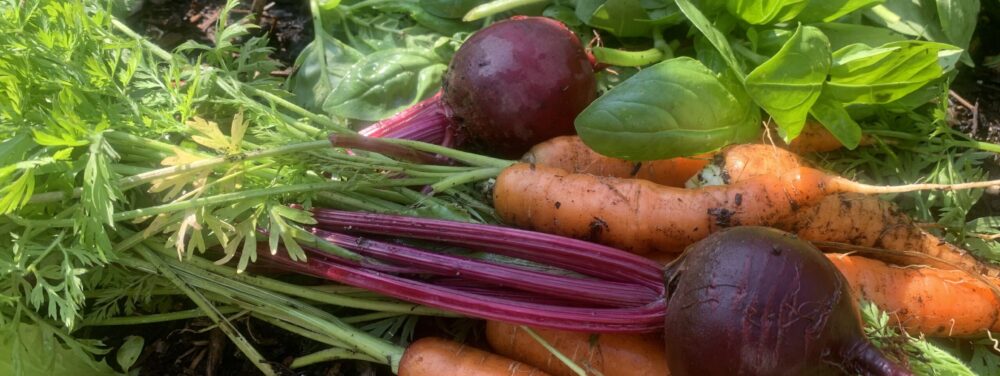I love homegrown potatoes for their taste, and for the fun I have harvesting them. But what I don’t love is when I pull my homegrown potatoes out of the soil, rinse the dirt off, and instead of seeing beautifully smooth skins, I see patches of ugly, wart-like, potato scab. What causes potato scab? Can you even eat potatoes with scab? And how do you prevent scab on potatoes?
What Is Potato Scab?
Patches of scab are brown and raised. You might see one scab patch, several small patches, or patches covering the entire potato.

What Causes Potato Scab?
Scab is a strain of bacterium called Streptomyces scabies that lives in the soil and attacks potato tubers and stems. Not only does scab live in the soil, it can remain living in the soil for an indefinite period of time.
Can You Eat Potatoes With Scab?
Yes, potatoes with scab are edible. If you don’t mind an ugly potato, simply peel the potato to remove the scab patches, cook, and eat. Scab doesn’t affect the taste of spuds.
How To Prevent Potato Scab (Is It Possible?)
Completely eliminating potato scab might not be possible. But now that you know what causes scab on potatoes, here are some simple things I’ve learned that might help you decrease the amount of scab on your homegrown spuds:
Crop Rotation
Get into a habit of practising crop rotation with your potatoes. Wait 4 years before growing potatoes in the same spot again. The scab bacteria lives in the soil and can survive through the winter. This means if you plant potatoes and those potatoes have scab, there’s a good chance other potatoes planted in that same spot will get scab, too. Scab can also affect carrots, rutabaga, radish, beets, and turnips.
Acidic Soil
Try decreasing your soil’s pH level. Scab has less chance of surviving in soil that has a pH of 5.2 or lower (acidic soil). This is why some gardeners say you should grow potatoes in acidic soil. It’s not that potatoes need acidic soil to grow. Instead, potatoes have a better chance of not getting scab if grown in acidic soil. Talk to the folks at your local garden store about organic, environmentally-safe products to lower your soil’s pH level.
Damp Soil
After planting your seed potatoes, keep the soil damp during the time that the tubers (potatoes) are forming. Tubers start to form about 4 to 6 weeks after planting. According to the University of Saskatchewan, water deeply once a week to maintain moisture in the soil. And mulch your potatoes to keep the soil moist. But be careful to not overwater. Too much water can rot your seed potatoes.
Healthy Seed Potatoes
Plant only healthy potatoes. If you use your homegrown potatoes as seed potatoes, make sure they are healthy. Do not save and re-plant scab-infected potatoes. If you purhcase seed potatoes, buy only certified seed potatoes.
Molasses
Try molasses. Some gardeners say molasses works because molasses has fatty acids that kill the scab bacteria. Before planting, mix unsulfured blackstrap molasses and water (1 cup molasses to 5 gallons of water) in a large container. Leave the mixture for 24 hours, then pour the mixture on the soil. Plant your potatoes. After planting, mix molasses and water again (at the same ratio), and then pour the mixture on the soil throughout the growing season. Be careful not to pour the mixture on the potatoes’ leaves. I haven’t tried the molasses solution, but maybe this year I will if nothing else works.
No Manure
Manure can help feed the scab bacteria, so do not add manure or compost that contains manure to your potato patch.
Scab-Resistant Varieties
Grow varieties that are resistant to potato scab. These potatoes have less of a chance of being infected with scab (no potatoes are completely immune to scab). For scab-resistant varieties, try Chieftain, Norland, Russet Burbank, Purple Viking, and Warba. I just planted Norland potatoes and I will soon be planting other scab-resistant varieties. For me, this option seems to be the simplest way to try to decrease scab on my potatoes, so I’m trying this option first.

So if you’ve been wondering what causes scab on potatoes, or how you can get rid of scab, now you know why and some things to try. Try one or more of these suggestions to decrease scab on your potatoes, and let me know if it worked.
And if you’re new to growing spuds, don’t let the idea of scab scare you. The post How To Plant, Grow, and Harvest Potatoes can help you grow and enjoy the taste of your own homegrown potatoes. Enjoy!


